
Zero Prestigetm Mega-Corporation
The new open-source corporate model. No employees, no profits.
Just doing nice things for total strangers 24 hours a day.
You can't buy this stuff yet but you can build it yourself.
p.s. Can I park my boat in your back yard?
Presents
THE KITEBOARD COOKBOOK
Build your own plywood kite board and other cool stuff.
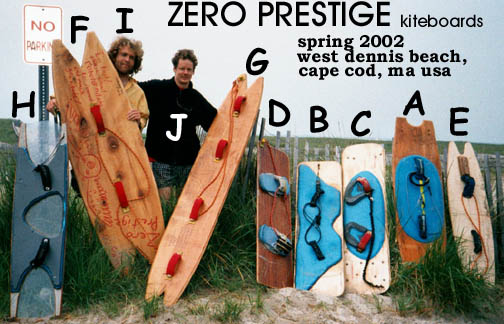 |
Build these darling kiteboards and more
yourself! It's easy and fun!
Unless otherwise stated, all boards are made of
plywood and are totally flat. For us and our conditions that's turned
out to be the best. Cool huh?
|
Q: What do distiguished critics
say about these boards?
A: Some give joy and some hurt. Here are the reviews:
A: Zero Prestige model Zero: 18"x63.25"
1/2"thick AC fir, two 2" high fins at each end, 1/2" rocker put in by
bending it with clamps, wetting the bottom and ironing the hell out of
it with a steam iron, our usual way. Easy to ride. After you're going
upwind reliably a flatter finless board points higher, is faster and
more fun. Unless otherwise noted, none of the other boards have fins. Good
beginner board.
B: Saul's Le Plank 1.1: 16"x56", 3/8" thick birch, no fins,
no rocker in the morning, 1/2" rocker at end of session. The first
great board for skimming the shallows at Nahant in a weak onshore
wind.The birch is nice and springy. Saul's true love. Great
all-round board.
C: Saul's Tasty Potato: 15.25"x60", 7/10" concave, 1/3"
rocker. Two layers 1/4" birch laminated on rocker table. The bottom
layer is a few inches shorter than the top layer, making planing steps
at the ends. Saul hates it, Tim loves it. Easy to hold an edge
overpowered. Heavy but still a good jumper. Easy to stick a landing,
not that anyone should care about that. Great all-round board for
some, nothing special for others.
D: Red mahogany "nice board": 14.75"x56" 1/2" mahogany with
teak face veneers. Was a masterboard from a yacht. Homemade "nice
straps" with 1/8" aluminum mounting plates, footpads carved from
homedepot soft foam floor panels. Tightening the plate screws gives the
board about 1/4" rocker and a flat spot in the middle. In rough water I
might want cutouts or tapered tips to get less spray in my eyes. Saul
rides the tail more and never gets spray in the face from square
boards. Good jumping board in more wind.
E: The Shark: A big windsurfer fin at one end of a little
1/2" thick birch board. Board outline copied from a Jimmy Lewis
picklefork. 1/2" clamp+iron rocker. Very hard to ride. At low speeds
you steer by edging, but at some speed the fin gets lift, you go
rocketing downwind because the lift is suddenly behind your foot.
Encouraging because the fin has lots of lift and not much drag, and the
airs (hard to call them jumps, because you have no choice) were huge.
Tried it again with another strap right over the fin, still too hard to
control as it switches modes. All the windsurfer-derived boards we
tried had this problem of having to instantly jump way back on the
board when the fin got lift. Tried it again without the fin, had too
much rocker for my taste and felt draggy. A flexible board needs to be
flatter initially. Bad.
F: The Flying Pig: 23.75"x79". 3/4" thick fir scrap plywood.
Fabulous low-wind board. You can waterski along the shore with two
burly guys pulling you with a rope. I added another set of straps
parallel to the first so you can turn it around and put your heels next
to the other edge when you're powered up. That makes it easy to ride
when the wind picks up or get back in to switch to a tiny board. I've
got video of a tandem ride, my (100lb)friend on my back, and a flag in
the background just hanging and wagging. The plywood has voids that
admitted water and the board warped, giving it 3/4" or so "mongolian
recurve" or whatever the opposite of rocker is called. Doesn't seem to
be a problem, might be an improvement. We had hours of great sailing
with this board while a trade-show's worth of expensive commercial gear
sat on the beach because it needed more wind. The expensive people who
owned that gear got really cranky. Best light wind board yet.
G: Sea Snake: 15"x92". 3/4" fir plywood. No rocker. Intended
as a tandem board, we still haven't tried it that way. It's very heavy
and I was very scared of it. Turns out it rides well in both light and
strong wind. In light wind you want your feet over the centerline of a
board. In high wind you want your heels right by the edge. This board
is narrow enough that you have both. This board is fast and feels a bit
like a big ski, which I guess is what it is. When you jibe the kite you
have to purposely stop the board, otherwise you'll just keep gliding
along, pass the kite and luff it badly. Just like on ice. Good
novelty board.
H. Saul's Glass-Bottom Board: 15.75"x59.75"Lexan riveted to
plywood frame. No rocker. Very slick and quick feeling board. It
convinced us that surface finish really does matter. Fascinating to
watch the water flow patterns and look into the water through the
board. Good board but a bit fragile.
I: Saul Griffith 190 lbs, J: Tim
Anderson 185 lbs
More Boards!
|
Missing Boards
We saw the trolley deposit our board bag on the runway at Logan. And
apparently that's where it stayed. So there we were on the Outer Banks
with no boards. What did we do?
|
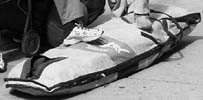
|
 |
Le Plank 1.0
We went to the lumberyard and bought a sheet of what
the timber industry calls SPF (spruce, pine, or fir, we think). It
already had a nice rocker built in (it was warped). Saul cut this one
56" x 16" and it was very nice. 1/2" thick. Footstrap centers 22.5"
apart on the centerline of the board. Strap anchors 7" apart. Depending
on what side was left in the sun, it had the full range of rocker and
it didn't seem to matter. Great board.
|
|
?
|
Q: What is proper footstrap
spacing and angle?
A: Try this test. Plant both feet on the ground. Now jump
as high as you can. Repeat a few times til your feet are going back to
the same place and it feels pretty good. Now measure that distance and
angle. Or just trace your feet onto the board. That's your strap
layout. Note the foot outline in the right strap above. There's a right
relationship between foot placement, board flex, distribution of
planing area, rider weight and style. This one is good. We don't really
have it figured out yet. Very similar boards can have different
behavior. See "Torpedo" and "Off My Rocker" tiny boards below.
|
 |
The Bloody Board
The picture speaks for itself. Saul used some pretty interesting
techniques including lasercutting to make this 1.75" thick wood-foam
sandwich board. Too much of the following: volume, rocker, fins, round
rails. very
many details and more
details and nice
pix of testing Bad |
 |
|
?
|
Q: How much volume should my
board have?
A: Way less than you think. It should be light so it
doesn't sink and get lost, but that's it. Strange as it sounds,
beginners especially benefit from low volume board. You won't believe
me or understand the reasons until you've tried it every other way, so
go ahead and repeat our mistakes. Hopefully our documentation will make
it quicker for you than for us. It took us years.
A kiteboard isn't a surfboard. A surfer doesn't have a rope pulling him
sideways. It's not a windsurfer. A windsurfer needs all that volume to
float the rig for a water-launch. A kite is a totally different
situation. You want a board that edges really well and lets you pull
hard on the lines all the time. And that's why God made little pieces
of plywood.
|
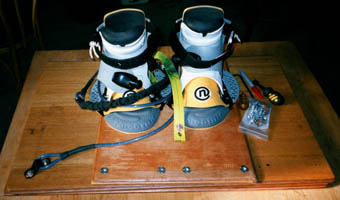 |
Lousy Travel Board
The Basketball Court: 19.75"x59.25" luan plywood. Seen
here ready to travel. A takeapart board with wakeboard bindings. Middle
section overlaps the two halves of the board. Held together with a
bunch of #10-24 flathead screws and tee nuts. 1/2" Clamp+iron rocker.
How'd it ride? Heavy, dead, slow, bad when overpowered, too much
rocker, too much flex. Just all wrong. And when the bindings come off
you, you're barefoot on sharp shells, and then you get infected, and it
hurts like hell to put the bindings back on, etc. etc. Painfully
Bad.
|
|
?
|
Q: How wide should my board be?
A: 16". Almost every
commercial board is between 37 and 42cm. (14.5"-16.5") We're crazier
than that but it still depends on weight, foot size, and experience. In light wind your feet should be over the
centerline of the board. In higher wind you want your heels right by
the edge but not dragging. If you've got size 12 feet 16" or so gives
you both those conditions without ever moving your feet, depending on
how deep in the straps you are and how much you toe-out the straps. If
the board is too wide you won't be able to control it, and if it's too
narrow it won't hold you up. If you're a beginner you'll mostly be
sailing underpowered and need a wider board, and if you're an expert
you'll already know what you want. We've had good rides in these
ranges: 13"-24" width, 100lbs-220lbs sailors, 6-50mph winds. If the
board tapers to the tips it can be wider than a rectangular board in
the same conditions.
|
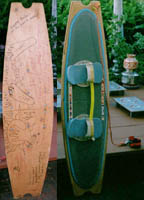 |
Okay Travel Board
18"x69", 1/2" thick luan. My elaborate travel board
leaning on the mandap where my brother was married in SF. Concave and
rocker, vacuum bagged laminations, breaks in half to avoid baggage
charges. Fully padded deck. The halves are joined by splints made from
chunks of hockey stick. One stick is enough for the toe side but the
heel side needed two layers of hockey stick to be stiff enough. There
was foam under the splints and you could adjust the rocker with the
splint attachment screws. It was best adjusted flat in the middle. The
padded deck looked nice but was unnecessary weight. This board was too
much work and too heavy. Okay.
Good Travel Board
|
|

|
That one had too much rocker and flex for its
length so I kept cutting it shorter til it looked like this and rode
really well. 60" long, 12" wide tips with cutouts 9" deep and wide.
Good shape. I like these new cutout tips because it handles chop well
and I get less spray in my face. Also they werer easier to cut with the
pullsaw I had with me than round cutouts. It's a little lighter now and
the weight is okay. Good. |
|
?
|
Q: How long should my board be?
A: 5ft. Between 3 and 12ft.anyway. If
it's short it'll be light and not have much planing area. If it's long
it'll have to be heavy to be stiff enough. Everything depends on
everything of course, but start at 5ft.
|
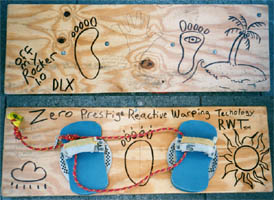 |
Instant Tiny Board
16"x48" Off My Rocker 1.0 DLX with Zero Prestige Reactive Warping
Technology RWT tm and abuncha other cool magic stuff: A piece of 3/8"
scrap fir from my brother's garage. Just a little rocker from
tightening the plate screws. Good to ride when powered up, very light,
easy to spin, kind of a skateboardy feeling. Lots of spray in my face
at first because it's so short and has big tips. Then I learned to turn
the board when I hit waves. Used it for a couple of weeks at 3rd ave.
in SF when my big board was too big. That's me in my tourist outfit. Good.
|
 |
|
?
|
Q: How much rocker should my
board have?
A: Except for your first board, little or none goddammit!!!!
As a beginner you'll be getting dragged straight
downwind and a half-inch or (insert huge amount) of rocker will make it
easier to keep the board between you and the water. Might as well have
upturned tips and a bunch of little fins all over it too. But once
you're trying to go upwind, you'll be edging the board hard, and for
most of us here in the kiteboarding paradise of Rumney Marsh, a flat
board with some flex feels best.
|
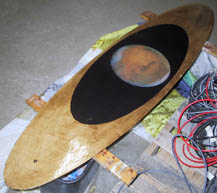 |
The Red Planet
15"x63", 3/8" birch. Eric Wilhelm weighs 145lbs, is 6'2" tall, has size
12 feet and made this board for an attempt to reach mars by kite. He
found it a better all-round board than any of the others. It has no
rocker and is an ideal oval. It also has really sharp edges and fell
over about a hundred times a day. I wish it had square tips so it would
stand up when leaned against the wall. Eric sez: "I made it an oval
because the corners of the rectangular boards kept throwing spray in my
face and every once in a while the corner would hit a wave and trip me.
Never had that problem on the red planet. Also, the foot straps were an
inch off of the center line, because the heels of my big feet dragged
in the water when I had them on the centerline." more
details Great board. Now lost.
|
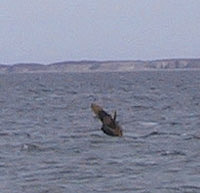 |
|
?
|
Q: I found one of your boards
in a tree. It has your email address on it. Should I email you?
A: Yes. You'll be made famous on this page as the first
person to return a lost board. We've lost a bunch of boards and they
all had a "please email me" message on them. Never heard a peep. I
guess all the nice people are illiterate or don't know what email is.
|
 |
Update! One Righteous Man
Lubos Vacha found one of Eric's boards hanging in a
tree in the NC outer banks in April 2003. Eric must have kicked it off
during high-altitude flight. What's even more amazing is that Lubos
read the board, emailed Eric and sent him his board back. Hooray for
Mr. Vacha and all Lubosians!! Let's surrender to them and let them do
statecraft and nationbuilding here.
Update! Another Righteous Man
I loaned out my balsa board and someone left it in the water at
pleasure bay. A fine gentleman found it and emailed me.
I have his picture and name here somewhere and hope to find it soon.
For now be of good cheer. Such people exist.
|
 |
The Torpedo 15"x50.3" 3/8"
birch. A tiny travel board, designed to fit in a golf bag. Eric wanted
to avoid baggage charges, and golf clubs travel free no matter the size
or weight. "Not to exceed 62 inches" means length+height+width<=62"
on some airlines. If you say "surfboard" they'll charge you anyway. He
was ready to tell them it was a special "golf stance enhancer" shaped
like a surfboard for that perfect swing. Eric sez: "It totally sucked!
It was way too small. The amount of power I needed to start planing
would then rocket me along the water until I luffed the kite. It does,
however, have the world's best footstraps. Since it was so light it
jumped pretty well. Good thing I wasn't charged for it." Bad
On further thought, this board was only tested right before a
thunderstorm in super gusty wind with a kitesurfer xxl that tended to
luff and fall into the water, on the last day of the season. So perhaps
it wasn't a fair test. Jury still out
|
 |
The Kevlar Guitar
18"x72"' 1/4" marine mahogany with sitka spruce raised stringers on the
deck. 1" high in the middle half of the board. 6oz glass cloth on top,
5oz kevlar on the bottom, which is flat and smooth. Very stiff board.
Very fast on flat water in light wind. Planes well on whitewater, which
is a very strange and nice feeling. Too stiff to jump well. The raised
stringers make it hard to move the straps to the right place. Also made
it a lot of work to fit in the deck pad. Toe side stringer isn't
needed. Very elaborate and pretty. Good special purpose board. |
|
?
|
Q: So how stiff should my board
be?
A: Just right. The fastest upwind board for a
straight-line run has no rocker. Cutting back and loading up for a jump
you want rocker to match your curved path. Then a flat rigid board
feels draggy and doesn't jump well. The best flex depends on your
weight, style, and where your footstraps are relative to the planing
area. I'll update this page when we've got the numbers :). I've made a
bunch of boards that were too flexible to be any good and one that was
too stiff to jump well but was great for other stuff. If the board has
wide tips you can bend the board more in a turn than if it's tapered
(that's a good thing).
|
To be added:
Dugong: 23.5"x76"
Dminus asym 18"x58.5"
etc. etc.
Tools and Techniques
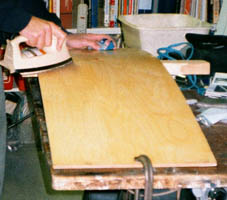 |
Putting in the rocker
We don't do this anymore because we like flat boards, but you might
enjoy it. The bottom surface of the plywood board must be raw wood, not
yet varnished or sealed. Clamp the board down, sponge water all over
the bottom, and steam iron the hell out of it. For a flat spot in the
middle use a prop near each end instead of the one in the middle shown
here. Leave the board clamped for a couple of days while it dries and
you catch up on humanitarian missions. On the right is another approach
used in the jungles of North Carolina.
|
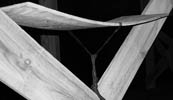 |
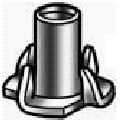 |
Stainless-steel Tee Nuts to
attach footstraps to board:
Drill a hole to fit the barrel, then hammer in the locking prongs until
the tee nut is flush with the bottom surface of your board. 10-24 is
lighter and plenty strong. Stronger than a human ankle anyway.
Get them from McMasterCarr.com
18-8 Stainless Steel
10-24 thread 9/32" high barrel part# 90973A040 $4.21 pkg of 10
1/4"-20 thread 3/8" high barrel part#90973A029 $4.28 pkg of 10
1/4"-20 thread 9/16" high barrel part#90973A114 $5.76 pkg of 10
The ones they sent us were made by Standard Fastenings, New Bedford MA
02745
Zinc-plated ones work just as well. Minimal rust even in salt water and
cost a lot less. Find them on the same catalog page. Way cheaper than
from home depot. |
|

|
Old and Broken
New Hotness
|
A Spade Bit to Countersink the
Tee Nuts with:
If your wood is too hard or you'd rather countersink than just pound
the tee nuts flush, use a bit with square corners like the lower one.
Get a 3/4" spade bit that looks like the top one and grind it, McMasterCarr.com part#2894A56
$2.21 or buy one that's already got square corners.
Use this countersink before you drill the press-fit hole or this bit
will jump around and make a mess. |
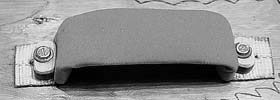
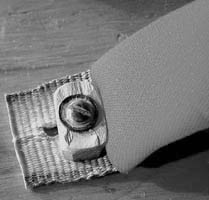 |
Quick and Easy Footstraps:
Now that you've got those tee nuts in, it's time to
make a footstrap or two.This kind is made from a 1ft chunk of truck
tiedown strap. The bolt goes through a new penny, a chunk of wood, and
a slot in the end of the strap. The slot makes it easy to loosen the
bolt and adjust the strap. Melt the ends of the strap so they don't
fray. Melt the slot and shove something in so it doesn't melt shut
again. That also makes sure the slot is wide enough for the bolt.
Varnish the strap to make it stiff and let it dry. Use contact cement
to make a tube of wetsuit neoprene 7" or 8" long depending on how big
your feet are. Put it all together so it looks like this. Your foot
should be snug in the strap and go in no further than the instep or
you're risking a broken ankle. Your tee nuts should be at least 7.5"
apart so you can get your feet out in a hurry even if your foot is
twisted sideways. Why use a new penny as a washer? This galvanized bolt
has survived many hours in saltwater without rusting. In 1981 or so
President Reagan took us off the copper standard and put us on the zinc
standard because the copper in a penny was worth more than a penny.
Those new zinc pennies prevent rust by acting as a sacrificial anode
just like the one on your outboard motor.
|
| |
Even Easier Footstraps:
Now we use a series of holes instead of a slot because it's more solid
and we only adjust straps on shore anyway, no matter how much velcro
they've got in them. Poke some holes in the ends with a soldering iron
and shove a phillips screwdriver through so it doesn't melt shut again.
Now you don't need to put the bolt throught the block of wood. Any
fairly stiff strap will do. I soaked a leather belt in melted wax to
make these. |
 |
Varnishing Tips
The halves of the travel board are resting on nails while the varnish
dries. This way you can varnish both sides at once. Where the nail
touches the varnish it's hardly disturbed. Zar exterior satin urethane.
Leave the brush in the can when you're done and you won't need to clean
it and it'll last indefinitely. Gas mask and rubber gloves to protect
your education. Now we use epoxy instead of urethane, it seals the wood
better. It's not uv resistant, but the boards are stored indoors and
it's not a problem. |
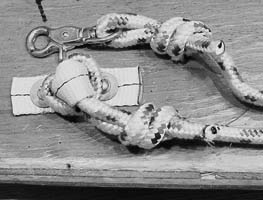 |
Instant Quick-Release Tether:
After much experimentation, all our boards now get one
of these. Use 5/16" braided polypropylene rope. Melt the ends, put on
the snap, double the end over and tie an overhand knot. How long to
make it? Just long enough to easily put your foot back in the strap
after a wipeout. That's usually 6 or 7 feet. If it's too long it'll be
flopping all over vexing you. Use really beefy strap to bolt it to the
board. I've lost a couple of boards when those broke. If you bolt it
down with a single screw as on the right, it can twist out, but you'll
notice it and twist it back in. |
 |

Closed

Open
|
Quick-release Board Tether Snap:
Here's the best kind of quick-release snap to put on your tether.
Get it from McMasterCarr.com
Round Swivel Eye Trigger Snaps: Bronze part# 3932T14 $2.17 each;
Type 316 Stainless Steel part# 3919T21 $7.81 each.
These are easy to put on with one hand and don't jam up with sand,
unlike some others.
Some people like to put them at both ends of the board tether so their
friends can borrow and lose it more easily. I mean so they can use it
with their other boards. |
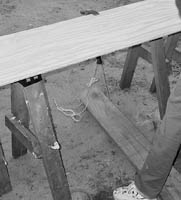 |
Using a Hammer as a Clamp
When all you've got is a hammer, it starts looking like all kinds of
things. A clamp, a drill, a screwdriver. Here's how to use it as a
handy clamp. Just step on the beam to clamp the board down. Good for
when you're rounding the top edges of the board. |
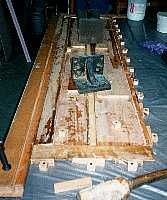 |
Gluing up a balsa kiteboard
blank
The tips, rails, and center stringer in this one are poplar. The steps:
Put plastic sheeting over a heavy flat solidcore door. Clamp scrap
boards along two edges. Lay out the boards you're going to glue up.
Screw wood blocks around the other two edges and make an equal number
of wedges. Mix up some epoxy and paint it on all the edges to be glued.
That keeps the wood from soaking up too much glue later and sucking the
joint dry. Mix the remaining epoxy with wood flour, phenolic or glass
microballoons, white flour, or whatever you like until it's got a
consistency between pancake batter and peanut butter. Spread that on at
least one edge of each joint. Pound the wedges between the boards and
the blocks to hold the whole thing tightly together. If the boards
won't lie flat pile heavy things on them or nail them down. Some people
use yellow glue or white glue instead of epoxy, that's fine too, cuz
the whole thing's going to be encasulated with fiberglass anyway. I
like epoxy because it fills and sands well and I have it.
|
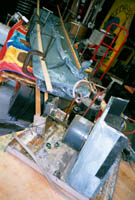 |
Vacuum Bagging
What's that? It's a way to clamp layers of plywood together while the
glue sets up. Get an airconditioner or refrigerator, cut the hose,
letting out the freon and and destroying the planet's ozone layer if
it's an old one. Put glue on your panels, put them on the rocker table,
put a plastic bag around them, use the pump to suck the air out. If
it's all perfect it'll give you 15psi of clamping pressure all over the
panels. That might not be enough, so add enough clamps at the edges til
everything is perfect and you wonder why you bothered with the pump.
Turns out if your board has compound curves e.g. both rocker and
concave, any kind of clamping that maintains the shape holds the whole
panels in contact.
|
 |
|
Frequently Asked Question:
Q: "Can't I just use my windsurf board? and
aren't fins better?"
A: In theory yes and yes. But the difference between
theory and practice is much bigger in practice than it is in theory.
Summary: After much striving and human drama, we all gave up
on directional boards entirely and fins mostly.
Here's a bunch of stuff that should have worked really well but didn't.
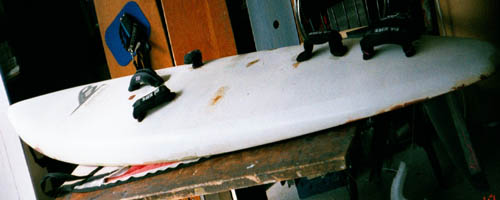 |
120 liter windsurfer set up for kitesurfing. That means
adding more footstraps further forward. I actually sailed the length of
Boston old harbor on this monster with a 5 meter sputnik 4 modified for
4 lines and handles. I really wanted to get that windsurfer-istic
feeling of drag decreasing with speed and the board skipping along just
slapping the water. To stay on this thing required a lot of screaming
and channeling James Brown ("Get On UP!) It was pretty scary. Big and
squirrely and had that huge sharp fin and once it was going fast seemed
like way too much board for a pair of skinny human ankles to control.
After surviving a wipeout it was really hard to fly the kite and get
back on it.
|
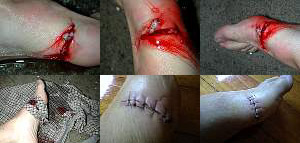 |
Saul kited his way into the air and landed on that big
fin, cutting his foot. For a while it seemed like every kite excursion
ended up with Saul in the emergency room. He developed a real antipathy
toward fins. Saul is the world's greatest optimist, which makes him
very accident-prone. He quite a collection of scars and an almost
complete set of x-rays from breaking most of the bones in his body over
the years.
|
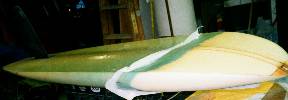
The Fat Tadpole, or according to Saul, The Tadpole with Teeth: I bought
a $10 windsurfer at a fleamarket, cut it in half and made a smaller
board. Saul didn't want to touch it or even stand near it, which showed
good sense. |
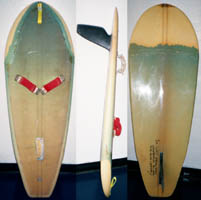 |
I put the straps about centered over the
planing area and then added another strap (not shown) over the fin. I
rode this across the Charles river in a very rough northwest wind
flying a 10.6meter Kitesurfer XXXL with handles. Conditions were so bad
that it actually seemed like the board sort of worked. Later in decent
conditions it became clear that it was nearly unrideable. Surely
physics was involved in some way. |
Why mess with fins at all and why didn't it work?
Planing is a pretty efficient way of getting lift if your
board is 5 degrees or less from horizontal. But when you're edging hard
you're scooping a pretty big trench in the water and that means drag. A
fin pushes the water around in a more orderly way and gives you a
better lift-to-drag ratio. So windsurfers go fast and have that nice
skipping-stone feeling. But a windsurfer has that tricky sail that acts
as an air-rudder for stability. The sail also provides a pitching
moment that lets you stand back over the fin and holds the wide part of
the board on the water to counteract the fin's heeling force.
With kite power you don't have that. Your stance has to be more
centered like a real surfer. For kiting you should put your body weight
over a spot just behind the center of buoyancy and that should be close
to the center of lateral resistance and the center of planing area. But
when you speed up and the fin gets lift you have to jump back over the
fin to keep from just shooting downwind. And then you've got way too
much board in the air in front of you and a big fin prying the thing
away from you and your ankles aren't strong enough for that. I kept
adding strap anchors and moving straps until things sort of worked. But
the boards are big and scary, too hard to control and not much fun. You
could make a "real" directional kiteboard with multiple short fins up
toward the center of plane and buoyancy. Fore-and-aft spacing of
multiple fins makes steering less twitchy, short fins take the load off
your ankles and round rails reduce the tendency to catch an edge. But
all those changes increase the drag til you've lost your advantage. And
because it's a directional you've got to take your feet out of the
straps and jibe the board toward the kite. Then the kite luffs or you
fall off the board and you wipe out and get dragged downwind. By
contrast twintips always stay on your feet and you never have to point
the board downwind. Yay twintips. Hmm. Howabout a twintip with a Big
Fin?
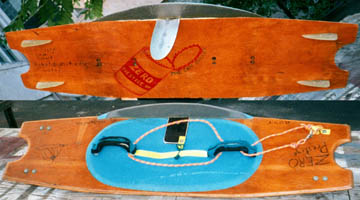 |
Model Zero became the Can Opener with the addition of a
Big Fin. 12.2" long, 4.1" chord, .26" thick. Foil thickness is ~6.5% of
chord. Parabolic-looking outline, modified double-ogive foil section,
which means circular arcs but blunted for health reasons. Thanks to
Dave Culp for foil advice. Nice graphic by Selena. Aluminum is very
slow stuff to work. Use fiberglass instead. Most rideable "Finnish"
board yet. Goes to windward well and feels slick once the fin gets
lift. The board wants to be flat on the water in the steady state
condition, and that means it needs upturned noses to keep from diving.
All the side force is concentrated in that narrow fin, and the board
can easily pivot around it, which makes it squirrely. Further fiddling
would involve bigger stabilizing fins at the tips, upturned noses with
planing steps at both ends, and maybe Hawaiian manu thingies on top the
tips. And I'd probably never jump for fear of all that hardware.
|
|
Sources
Epoxy www.uscomposites.com
1-561-588-1001 Here's my last shopping list: (don't worry, the normal
stuff is for a canoe)
Epoxy $75 for 2.5 gallon kit part#EPOX-635414
EPX-P41 4-1 Ratio Pumps $4.95 / Set of 2
4oz E Glass Style: 1522 Plain Weave Thickness: 0.0059" FG-C0450 50"
Width $4.30/yd
6oz E Glass Plain Weave Thickness: 0.0093" FG-C0660 60" Width $5.20
7 1/2oz E Glass Plain Weave Thickness: 0.0107" FG-C0750 50" Width
$5.00/yd
7 1/2oz Cloth Tapes Plain Weave Thickness: 0.0107" FG-C02 2" Width
$.55/yd $14.95 $13.50/roll
2 LB Density Urethane Foam FOAM-0204 4 LB Kit 2 Cubic Feet $15.00
You'll also want to get microballoon powder if you're fairing surfaces
and flour for thickener if you're gluing wood, an infinite number of
cheap 1.5" wide brushes, and a gross of rubber gloves.
Plywood www.mainecoastlumber.com
17 White Birch Lane, York, Maine 03909 tel 800-899-1664,
207-363-7426, Fax 207-363-8650
I've bought Baltic Birch, 3mm exterior Okoume $28.48, 6mm marine
Meranti $33.07, white ash, hickory. They have 12ft sheets, and sawn
planks of many species of cool wood. I went up, smelled and fondled
their stock once. Unfortunately they don't have the prices on their
website, but they don't mind talking on the phone. There's a $30 flat
rate delivery charge in New England.
Hardware McMasterCarr.com
They've got secret underground warehouses every few miles. So you'll
pay cheap postage and get the stuff the next day. The only thing that
isn't in their catalog is the catalog itself. That's a problem because
their catalog is really nice, they run out, and people kept "borrowing"
mine from the mailroom before I got it. I spent a few hours a year
trying to talk them into selling their catalog in their catalog. Then
when the salesman says "but I already gave you one" you could still get
one.
Dayglo Pigment Day-Glo
Color Corp 4515 St.Clair Ave. Cleveland OH 44103 (216)-391-7070
We've used saturn yellow GT-17-N. Add these bright pigments to your
epoxy to make your board more visible without hiding the pretty
woodgrain. If you urethane varnish over the epoxy to protect it from
UV, add some dayglo to that too. Even with that it's pretty hard to
keep your eye on your board when your kite is dragging you away from
it. The best thing is to swim back to it and let your kite float. The
kite's worth more but it will be visible for miles.
zeroprestige.org the group
blog and archive for kite builders
Tim's homepage Contact
me robot@(jeez louize I hate spam)mit.edu with suggestions, bug reports
etc. (cut this stuff from email addr first)
Copyright Tim Anderson 2003 various pictures copyright Saul Griffith
and Eric Wilhelm - check out their works at squid-labs.com and
zeroprestige.org.


































